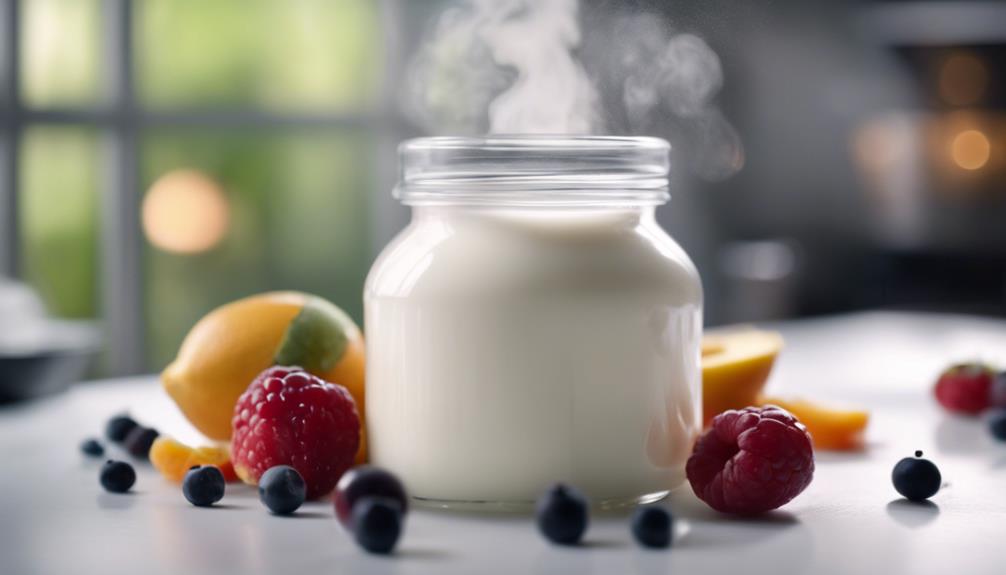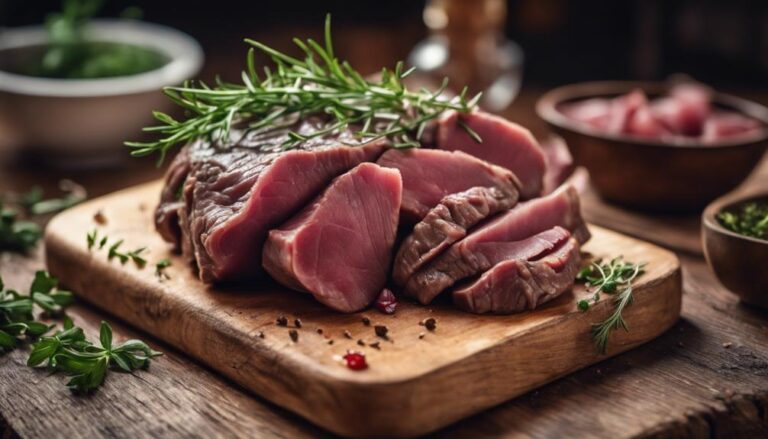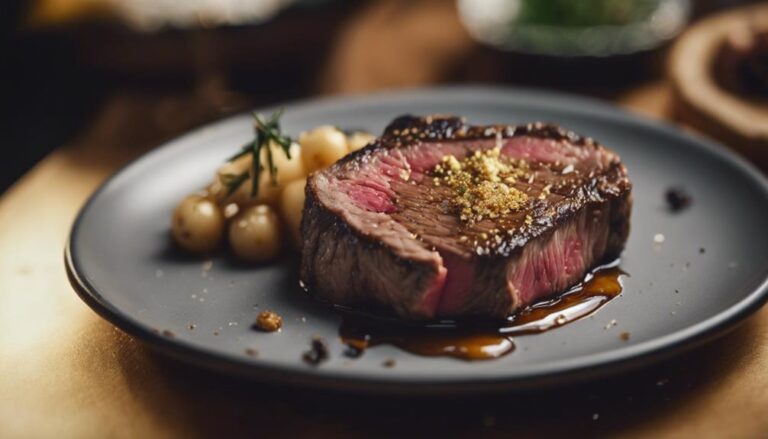Sous Vide Yogurt: Cultured and Creamy
To achieve cultured and creamy sous vide yogurt, maintain precise temperature control ensuring ideal fermentation conditions. Monitor incubation heat for a velvety consistency. Select bacteria strains carefully for desired texture. Timing fermentation accurately enhances flavor development. Utilize fine mesh strainers to achieve desired thickness by removing whey. Live cultures in controlled temperature enrich yogurt with probiotics. Experiment with chia seed or lemon-infused yogurt variations for unique flavors. Master thickening techniques with cheesecloth or full-fat milk. By following these scientific methods, you can savor the harmonious blend of culture and creaminess in your sous vide yogurt.
What You Will Learn Here
- Precise temperature control ensures optimal fermentation
- Extended fermentation time enhances flavor and creaminess
- Choosing the right bacteria strain impacts texture
- Sous vide method ensures consistent temperature for cultures
- Experiment with different flavors and ingredients for unique yogurt variations
Yogurt-Making Techniques
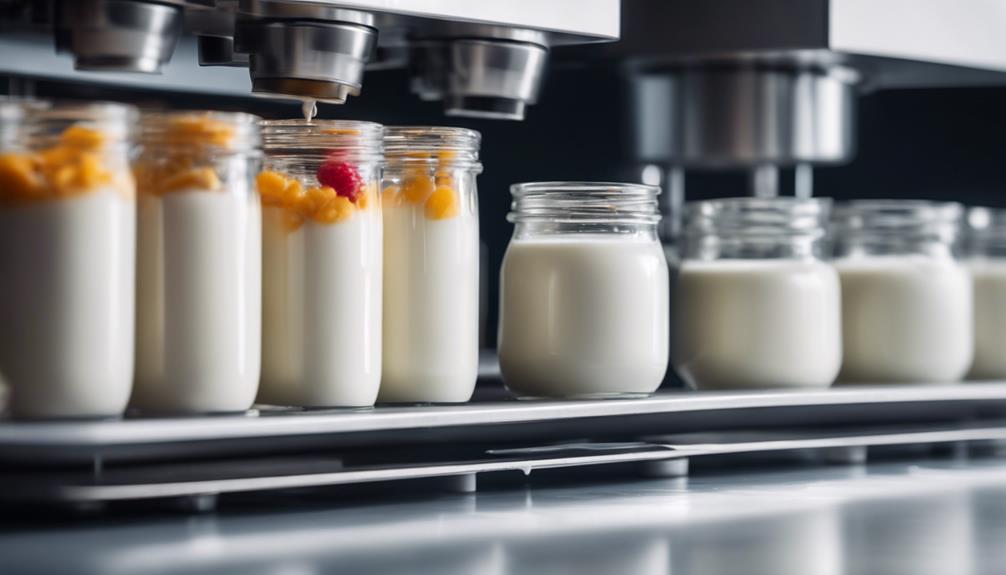
Maintaining precise temperature control during the fermentation process is essential for producing high-quality yogurt. The time it takes for the yogurt to ferment will directly impact its flavor and consistency.
Additionally, choosing the right strain of bacteria will influence the thickness and texture of the final product.
Temperature Control Importance
Proper temperature control is vital when making yogurt to guarantee the ideal environment for the cultures to thrive and produce a creamy end product. Temperature accuracy is essential for fermentation success.
Maintaining the right heat control during the incubation period ensures that the yogurt cultures can multiply and convert the milk into a creamy consistency. For best results, it's recommended to monitor the temperature closely using a reliable sous vide machine or thermometer.
Consistency in temperature throughout the process is key to achieving the desired texture and flavor in your homemade yogurt. By paying attention to temperature control, you create an environment where the live cultures can flourish, resulting in a deliciously creamy and tangy yogurt for you to enjoy.
Time for Fermentation
To achieve excellent fermentation results in yogurt-making, precise timing is vital to allow the live cultures to develop and transform the milk into a creamy texture. Fermentation duration greatly impacts the flavor profile of the yogurt. Longer fermentation times generally result in tangier yogurt due to increased lactic acid production, while shorter times yield milder flavors.
Temperature fluctuations can affect fermentation timeframes, with higher temperatures speeding up the process but potentially altering the final taste. It's important to maintain consistent temperatures during fermentation to guarantee the desired flavor and texture. Monitoring the fermentation duration closely is key to achieving the perfect balance between tanginess and creaminess in your homemade yogurt.
Strain for Thickness
Have you considered using a fine mesh strainer to achieve ideal thickness in your homemade yogurt? Straining methods are essential for achieving the desired consistency.
By straining the yogurt after it has fermented, excess whey is removed, resulting in a thicker texture. Experiment with different straining times to customize the thickness to your liking.
Additionally, straining can also be a method to enhance flavor by concentrating the yogurt. You can explore flavor experimentation by combining ingredients before straining, such as adding honey, fruits, or vanilla extract.
This process allows for endless possibilities in creating unique and delicious yogurt variations. With the right straining techniques and ingredient combinations, you can achieve perfectly thick and flavorful homemade yogurt.
Key Yogurt Components
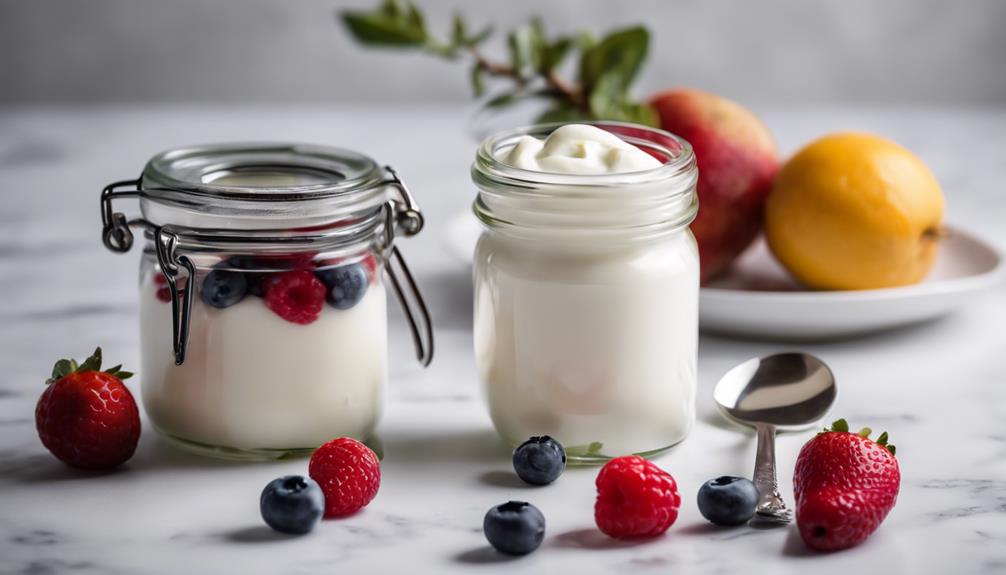
Understanding the key components of yogurt is essential for mastering the art of making this cultured and creamy delight. Yogurt is a complex product with several important components that contribute to its taste, texture, and health benefits. Here are some key components to keep in mind:
- Milk: The primary ingredient in yogurt, milk provides the proteins, fats, and sugars necessary for fermentation and flavor development.
- Live Cultures: These beneficial bacteria are essential for the fermentation process that transforms milk into yogurt. They also provide probiotic benefits, aiding digestion and boosting the immune system.
- Whey: The liquid byproduct of yogurt production, whey contains proteins and water-soluble vitamins, adding to the nutritional value of yogurt.
- Lactic Acid: Formed during the fermentation process, lactic acid gives yogurt its tangy flavor and helps preserve the product by creating an acidic environment that inhibits harmful bacteria growth.
Understanding and balancing these components is vital for creating delicious and nutritious yogurt at home.
Yogurt Flavor Varieties
You can explore a range of delightful yogurt flavor varieties to tantalize your taste buds.
Try making a rich and creamy Greek yogurt using sous vide techniques, or experiment with a zesty lemon-infused yogurt for a invigorating twist.
Additionally, consider adding chia seeds to your yogurt for a nutritious and texturally pleasing option.
Creamy Greek Yogurt Recipe
Craft a creamy Greek yogurt by blending high-fat milk with live cultures, resulting in a tangy and rich flavor profile. When preparing this delightful treat, consider the following to enhance your experience:
- Indulge in Richness: Enjoy the luxurious creaminess that high-fat milk brings to your yogurt.
- Savor Tanginess: Delight in the zesty and tangy notes that live cultures impart to your Greek yogurt.
- Experience Homemade Satisfaction: Revel in the joy of crafting your own nutritious yogurt at home.
- Discover Nutritional Benefits: Benefit from the probiotics and calcium present in this homemade delicacy.
These elements combine to create a delicious and wholesome Greek yogurt that will surely satisfy your palate.
Lemon-Infused Yogurt Recipe
Infusing yogurt with the invigorating essence of lemon elevates its flavor profile, offering a citrusy twist to this creamy dairy delight. The zesty lemon perfectly complements the tanginess of yogurt, creating a revitalizing and vibrant taste experience.
When preparing this lemon-infused yogurt, consider experimenting with different fruit infusions to enhance the overall flavor complexity. Additionally, this yogurt pairs exceptionally well with various savory dishes, making it a versatile ingredient for both sweet and savory pairings.
The delicate balance of creamy yogurt and zesty lemon creates a harmonious blend that tantalizes the taste buds. Try incorporating this lemon-infused yogurt into your recipes for a burst of citrus freshness that will elevate your culinary creations.
Chia Seed Yogurt Recipe
Incorporate chia seeds into your yogurt to create a textured and nutritious blend that enhances the overall flavor profile of this dairy product. Chia seeds are packed with omega-3 fatty acids, fiber, and antioxidants, providing numerous health benefits. When combined with yogurt, they add a delightful crunch and a subtle nutty flavor. Experiment with flavor combinations like honey and almond, or mixed berries for a delicious twist.
To boost the probiotic content of your chia seed yogurt, consider using alternative fermentation methods such as adding kefir grains or a probiotic capsule to the mix. This process enhances the yogurt's gut-friendly bacteria, promoting digestive health and overall well-being. Enjoy this wholesome and flavorful treat as part of your daily routine.
- Chia seed benefits: Omega-3 fatty acids, fiber, antioxidants
- Flavor combinations: Honey and almond, mixed berries
- Alternative fermentation methods: Kefir grains, probiotic capsules
- Probiotic options: Gut-friendly bacteria, digestive health
Yogurt Texture Enhancements
To achieve a creamy texture in your yogurt, consider adjusting the fat content of your milk or adding stabilizers like gelatin. Experiment with thickening techniques such as straining the yogurt through cheesecloth or using pectin to achieve a thicker consistency.
Secrets to a smooth yogurt include proper fermentation times, gentle handling of the yogurt during cooling, and utilizing high-quality milk for a rich mouthfeel.
Creamy Texture Tips
How can you achieve a velvety smooth texture in your homemade yogurt? To enhance the creamy consistency of your yogurt, consider the following texture techniques:
| Texture Techniques | Description | Benefits |
|---|---|---|
| Straining | Use a cheesecloth to strain the yogurt, removing excess whey and thickening the texture. | Improves creaminess and thickness. |
| Full-Fat Milk | Opt for full-fat milk to increase the fat content, resulting in a richer and creamier yogurt. | Enhances mouthfeel and creaminess. |
| Longer Fermentation | Allowing the yogurt to ferment for a longer period can develop a smoother texture and tangier flavor. | Improves creaminess and taste. |
Thickening Techniques
To further enhance the thickness and consistency of your homemade yogurt, implementing effective thickening techniques is essential. Thickening agents play a significant role in achieving the desired texture.
Consider incorporating ingredients like pectin, gelatin, or tapioca starch during the fermentation process to help thicken the yogurt. These agents work by binding water molecules, resulting in a denser final product.
Additionally, controlling the consistency throughout the fermentation process is important. Stirring the yogurt at regular intervals can help distribute the thickening agents evenly, ensuring a smooth texture.
Moreover, focusing on flavor development alongside texture enhancement is crucial. Experiment with different thickening agents to find the perfect balance between thickness, consistency, and flavor in your homemade yogurt.
Smooth Consistency Secrets
Achieving a smooth consistency in yogurt can be enhanced by incorporating precise techniques during the fermentation process. To achieve a smooth texture and tangy taste, make sure the milk is heated to the ideal temperature before adding the starter culture.
Maintaining a consistent temperature during fermentation is essential to develop a creamy consistency and rich flavor. Stirring the yogurt gently during the fermentation process can also contribute to a smoother texture.
After fermentation, refrigerate the yogurt to halt the culturing process and allow the flavors to develop further. By following these steps diligently, you can achieve a yogurt with a velvety smooth texture, tangy taste, creamy consistency, and rich flavor that will delight those you serve.
Final Thoughts
In conclusion, mastering the art of making sous vide yogurt yields a delectably tangy and velvety treat that is both satisfying and rewarding. Through flavor experimentation and fermentation benefits, you can create unique variations that cater to different palates. Controlling creaminess and customizing your yogurt allows for a personalized touch to each batch, ensuring a delightful experience for yourself and those you serve.
| Benefits | Customization |
|---|---|
| Enhanced flavors | Adjusting creaminess |
| Gut-friendly | Adding mix-ins |
| Probiotic-rich | Experimenting with toppings |
Frequently Asked Questions
Can I Use Non-Dairy Milk for Making Sous Vide Yogurt?
Yes, you can use non-dairy milk such as almond, coconut, soy, or oat milk to make sous vide yogurt. These alternatives work well and offer a variety of flavors for those with dietary preferences or restrictions.
What Is the Ideal Temperature for Probiotic Yogurt Cultures?
To optimize probiotic benefits and yogurt cultures, maintain precise temperature control during the fermentation process. Ideal temperatures for probiotic yogurt cultures range around 110-115°F. Consistent heat fosters the growth of beneficial bacteria, producing a creamy, tangy yogurt.
How Long Does Sous Vide Yogurt Stay Fresh in the Refrigerator?
To maintain the longevity of your sous vide yogurt, store it properly in the refrigerator. This helps in preserving its freshness. Typically, sous vide yogurt can stay fresh for about 1-2 weeks in the refrigerator, ensuring ideal taste and quality.
Can I Add Fruit Puree Before or After the Sous Vide Process?
You can add fruit puree either before or after the sous vide process for your yogurt. Experiment with different timings to control the intensity of fruit flavor. Pre-sous vide puree may offer a more infused taste.
Is It Possible to Make Greek Yogurt Using the Sous Vide Method?
Yes, you can make Greek yogurt using the sous vide method. By adjusting the time and temperature, you can achieve the desired consistency. The controlled sous vide technique guarantees a thick texture, similar to traditional Greek yogurt.
Conclusion
To sum up, sous vide yogurt offers a precise and controlled method for creating cultured and creamy yogurt. By maintaining a consistent temperature throughout the fermentation process, sous vide technology allows for the development of a wide range of flavors and textures.
Whether you prefer a tangy Greek yogurt or a smooth and creamy French-style yogurt, sous vide techniques can help you achieve your desired results every time. Experiment with different ingredients and techniques to create your perfect homemade yogurt.
